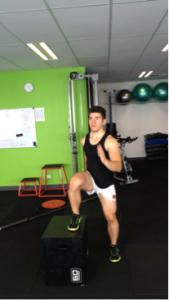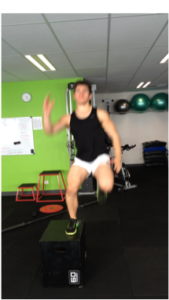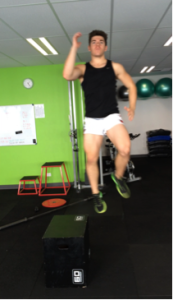How do I improve my vertical leap via strength training?
The vertical leap is a very important ability in footy, due to the amount of aerial contests or movements in the game. Contrary to popular belief, this is an ability that every player can benefit from improving – however this is obviously an ability that is vital to taller and key position players like ruckmen and key forwards and defenders, and therefore should be a central pillar to the strength-training program of these types of players.
It is also widely and well known that proper strength training is a key ingredient to improving this ability, and as a result, many junior and amateur level footballers are now looking to strength training to improve their vertical leap. But the question I often get is how? And which exercises are the best?
Well the first thing to do is to drop the leg press because this will do nothing for your vertical leap, and at worst even regress your existing leap. We have covered this elsewhere, so I’ll move on to 4 key points in regards to appropriate strength training to improve your vertical leap.
Train similar movements
Strength training with movements that have a high degree of motor program compatibility to the vertical leap, ensures a high level of transferable strength to the movements associated on gameday. Simply having strong leg muscles in general will not necessarily mean that this strength will translate to being able to jump high off one leg or 2. In other words, a strong muscle does not automatically translate to strong movement ability and movement quality. Football is about movement, not muscles – and you would only need to get the most impressive looking bodybuilder at your gym with the biggest most ripped vascular quads, and get him to show you how high he can jump (or how high he cant), to realise how true this statement is. So the 2 exercises that should be at the top of your training list if you want to improve your vertical leap are the squat (for double-leg jump) and the step up (for single-leg jump), due to their very similar biomechanics to these skills and therefore their high motor program compatibility.
Training for both double-leg and single-leg
Whilst a squat will allow you to lift a far greater load, and therefore provides the potential for more strength gains in terms of the absolute load you’re using, it is important to remember that we are after strength move ments that have a high degree of motor program compatibility with game day movements. You will have likely noticed when playing or watching that the overwhelming majority of jumps performed are off of 1 leg, not 2. Therefore, whilst the squat has a high degree of motor program compatibility with the double-leg jump, it has far less compatibility, and therefore transferability, to a single leg-jump, which is a different motor program. Furthermore, it has been shown that double leg strength has very little carryover to single leg strength, whereas the carryover from single leg strength to double leg strength is actually very high. In other words despite being different movements and motor programs, step ups will transfer to double leg jumps considerably more than squats will transfer to single leg jumps. I am not saying drop the squats – by all means they are one of the absolute locks in any strength training program for footy – but what I am saying is that when vertical leap is a key movement quality goal of yours, the step up is equally a important and probably even more so than the squat.
ments that have a high degree of motor program compatibility with game day movements. You will have likely noticed when playing or watching that the overwhelming majority of jumps performed are off of 1 leg, not 2. Therefore, whilst the squat has a high degree of motor program compatibility with the double-leg jump, it has far less compatibility, and therefore transferability, to a single leg-jump, which is a different motor program. Furthermore, it has been shown that double leg strength has very little carryover to single leg strength, whereas the carryover from single leg strength to double leg strength is actually very high. In other words despite being different movements and motor programs, step ups will transfer to double leg jumps considerably more than squats will transfer to single leg jumps. I am not saying drop the squats – by all means they are one of the absolute locks in any strength training program for footy – but what I am saying is that when vertical leap is a key movement quality goal of yours, the step up is equally a important and probably even more so than the squat.
Progress from functional strength to footy specific power
The end goal to strength training for footy isn’t actually to be stronger. This may sound strange, but the gains in functional strength in different movement tasks are a stepping-stone to the real end goal – which is the improvement in footy specific expressions of power. Improvements in strength are vital, because without strength gains, there can be no genuine improvement in other abilities like power or agility, because strength is the underlying physical quality on which all other qualities are built on top of. Therefore once an adequate base of functional strength in movements such as step-ups and squats has been developed, you must then build on this with plyometric movements such as explosive step-jumps and squat-jumps, including different variations of these. Furthermore, performing explosive weights movements of the same movement, but with only 1/3 – ½ the original weight, has also been shown to be a good tool for developing such power. However there is still some debate about the slowing down at the end of the range of movement with this form of training (because otherwise you would be throwing the bar to the ceiling), which doesn’t exist with plyometrics, and there is the feeling that this deceleration may train to slow down the end of a movement.
Periodisation and correct programming are vital
Periodisation is as important a component to a functional strength training program for footy as any other. It doesn’t matter what exercises you choose – even with the best and most footy specific exercises selected, if the exercises aren’t progressed appropriately, the gains in movement ability will be diminished. What exactly is periodisation? There is a fair bit that goes into periodisation, particularly for a sport like footy, and is covered in detail in Functional Strength Training for Australian Rules Football, however a good way to look at peridisation is like a pyramid, where 1 block of training is built on top of another, with one period laying the foundation for the next period to be built on. That is, a particular period of training, with its specific goals, is also aimed at preparing your body for the next period of training, in order to produce better athletic results, as well as less injury. Because simply performing and conditioning anything at the same time will not produce the same high quality results, and it certainly will not minimise injury.
 Periodisation Pyramid – Building each phase on top of the previous platform
Periodisation Pyramid – Building each phase on top of the previous platform
In other words, your plyometric and power style step, squat and jump training should only be performed once an adequate amount of maximal strength in the appropriate movements (squats, steps, etc) has been developed. Because if you instantly jump into things like plyometrics, not only will you greatly increase the chance of injury, but you will also have no actual strength gains to work with to convert to footy specific expressions of power.
Programming of the variables of exercises is also important when training for something like improving your vertical leap, because ‘3 sets of 10’ just wont cut it. Like periodisation, there is a lot of information behind this point in terms of programming for footy, but generally speaking when training for ‘maximal strength’ in something like step ups, you would want to be training in rep ranges of 6-8 reps max, and for squats, 3-5 reps max, moving as much weight as you can, rather than doing bodybuilding style sets to exhaustion at higher rep ranges and lower weights. Then when progressing to the plyometric and explosive movements, the focus isn’t about reps, but about the speed, power and the quality of the movement. So when performing step up jumps for example, you wouldn’t do the sets ‘for sets of 5’ or ‘sets of 8’, but rather perform the reps as powerfully and explosively as possible, generating as much height as possible, and stopping the set as soon as height or speed diminishes. Because remember, you are training for power and speed of movement with a vertical leap, and therefore slow reps aren’t good. Like the old saying goes, ‘train slow, play slow.’
Strength Coach
Learn more about periodisation specifically for footy





